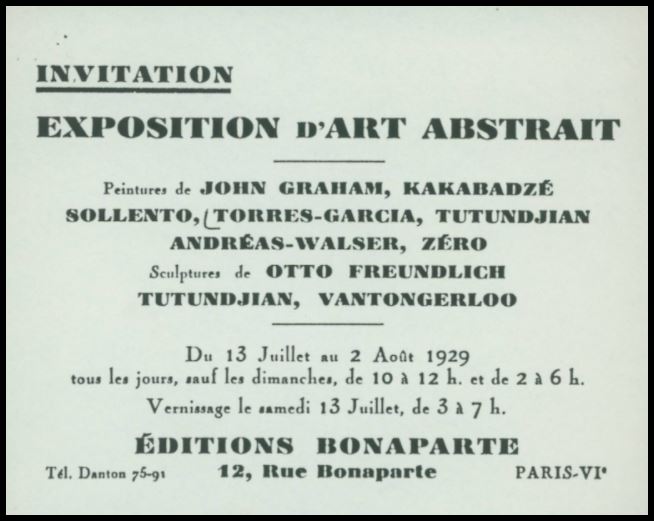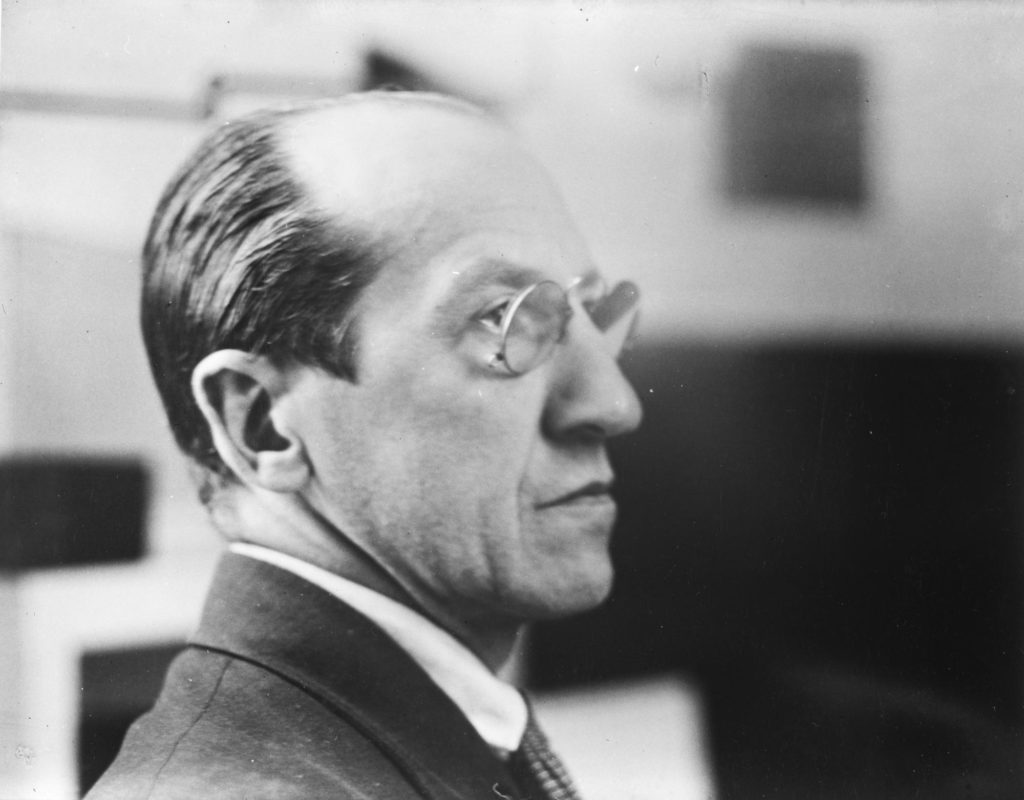by Wietse Coppes

In October 2021, the RKD – the Netherlands Institute for Art History received a surprising bequest from Onno Boers (1936-2021), consisting of hundreds of artists’ letters from the twenties and thirties of the previous century. A significant part of these, including three previously unknown letters by Piet Mondrian, appeared to be addressed to Paris-based Dutchman Leopold van Oijen. In the late nineteen twenties, this publicist and administrator was associated with Galerie Bonaparte and was founder of an ambitious, but currently forgotten Parisian art society which included Mondrian as well.
Leopold van Oijen
Leopold Willem Herman van Oijen was born in The Hague on 15 September 1894. After a career in the Dutch army, where he climbed the ranks to become artillery commander Lieutenant-Colonel, he changed course and aged 30, established himself in Paris. There he became involved with the ambitious and also idealistic Galerie Bonaparte, which was led by Dutchman Léopold Emmanuel van Leer, and which was located at 12 Rue Bonaparte. Van Oijen became responsible for the catalogues the gallery published and other (art-historical) publications, the Éditions Bonaparte. Prominent, modern artists held exhibitions there, and lectures and conferences were organized. The purpose of these activities was not merely to sell the modern works exhibited by the gallery, but above all to bridge the gap between the public and avant-garde art. This ideology would later also be adopted by Van Oijen when he founded an art society, as set out below. Besides his work for Éditions Bonaparte, van Oijen, as publisher and founder, was also involved with other Parisian periodicals and societies. For instance, he was director of L’informations féminine, founded in 1927 under the editorship of well-known French feminist Marcelle Kraemer-Bach.
Contact with Mondrian
Exactly when and how Van Oijen and Mondrian first came into contact with each other has so far remained unclear. Mondrian was well familiar with the Parisian gallery world, especially with the limited number of those which exhibited modern art. It seems likely that Mondrian was introduced to Van Oijen through Galerie Bonaparte and the Dutch gallery owner Van Leer. The earliest documented contact between Mondrian and Van Oijen is dated 3 April 1930. That day Mondrian thanked him by letter for the invitation to the opening of Willi Baumeister’s exhibition in Galerie Bonaparte, and he writes how, ‘because of special circumstances’ (from other letters it appears that he had suffered a bout of rheumatism in his hip and leg) he would not be able to attend until later in the afternoon. The next surviving letter dates from October 1931 and contains Mondrian’s congratulations on the reopening of the gallery, which apparently had been reconstructed. Mondrian writes how pleased he is that despite ‘la triste période actuelle’, the gallery’s business is flourishing. This is probably a reference to the economic crisis at the time, caused by the Great Crash of 1929. The art sector was, of course, badly hit by the effects of the recession. The third – and final – surviving letter of Mondrian to Van Oijen is not dated. Since this letter contains a list with the names of twenty architects who may have been interested in becoming a member of the ‘Cercle Artistique de Paris’ founded in 1931, this letter too can be dated around the same time.

Cercle Artistique de Paris
In 1930, Van Oijen decided to found this society of modern artists and architects. To that end he undoubtedly tapped into contacts he had established at Galerie Bonaparte. The many prominent artists Van Oijen was in communication with could themselves also introduce artists. This becomes clear from the letter containing the list of architects described above. The letter is not only signed by Mondrian, but also by the painter Fernand Léger and the architect André Lurçat, who at one time worked in the office of Robert Mallet-Stevens. In November 1931, Van Oijen’s efforts resulted in the founding of the aforementioned Cercle Artistique de Paris. This society intended to bring together the finest representatives of painting, sculpting, architecture, theatre, film, music, letters and criticism. Its purpose was two-fold: on the hand, the society was meant to improve relations between the different disciplines, on the other hand, the immediate contact between artists and the public needed to be restored. In Van Oijen’s view that contact had become disrupted due to the involvement of the art trade. The public had to be reconnected by holding a sales exhibition and other activities in the society’s meeting house in the vicinity of the de Place de l’Étoile (currently Place Charles de Gaulle). Reports indicate, however, that the address for correspondence continued to be that of Galerie Bonaparte for quite some time.

Muiderkring
Reports about the establishment of the Cercle Artistique de Paris even reached the Netherlands. From an article that appeared in the Provinciale Geldersche en Nijmeegsche Courant newspaper, we know that at its founding, Van Oijen alluded to the Muiderkring (the Muiden circle). This refers to the circle of writers, scientists and visual artist surrounding the Dutch poet P.C. Hooft, who from 1609 resided at Muiderslot castle, near Amsterdam. From approximately 1621 onwards, regular meetings were held at the castle, attended by varying groups of van Hooft’s friends, all of whom played prominent roles in Dutch cultural life. By calling to mind the Muiderkring, Van Oijen drew attention to the kind of successful artistic and intellectual cross-pollination he envisioned when he founded the Cercle. The group devoted to painting was led by Henri Matisse and had as its members ‘all champions of living art from Picasso to Mondrian’. Despite the founding of this ‘new art centre’, little seems to have come of the idealistic plans Van Oijen had envisaged. As far as we know, the society never held an exhibition, nor is there evidence of any other activity, apart from an assembly of members in February 1932. Whether or not the architects nominated by Mondrian, Léger and Lurçat were actually ever included in the circle is not known either. The letters donated to the RKD, however, do shed more light on the origins of this society and on the rich cultural network of that currently all but forgotten Dutch Parisian, Leopold van Oijen, who somewhere prior to 1942 made his way back to the Netherlands, where he died in 1976. Mondrian’s letters to Van Oijen will in due course be published in full in The Mondrian Papers.
Members of the Cercle Artistique de Paris Painting Section André Beaudin / Roger Bissière / Maurice Brianchon / Paul Burlin / Marc Chagall / Serge Charchoune / Roger Chastel / Gio Colucci / Jean Crotti / Béla Czóbel / Giorgio De Chirico / Raoul Dufy / Serge Férat / Otto Freundlich / Édouard Goerg / Marcel Gromaire / Robert Guénine / Pincus Krémègne / André Lhote / Tadé Makowski / Henri Matisse / Piet Mondrian / Roland Oudot / Amédée Ozenfant / Per Krohg / Pablo Picasso / Gino Severini / Chaïm Soutine / Jean Souverbie en Léopold Survage. Sculpting Section Etienne Beothy / Constantin Brancusi / Harold Cash / Paul Cornet / Joseph Csaky / Leon Ernest Drivier / Pablo Gargallo / Marcel Gimond / Mateo Hernandez / Leon Indenbaum / Henri Laurens / Jacques Lipchitz / Jacques Loutchansky / Oscar Miestchaninoff / Pierre Poisson / Auguste Suter / Robert Wierick en Ossip Zadkine